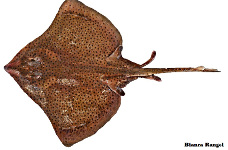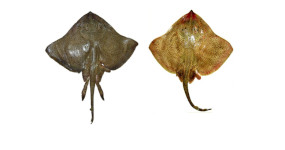Atlantoraja castelnaui
(Miranda Ribeiro, 1907)
Spotback skate
Classification: Elasmobranchii Rajiformes Arhynchobatidae
Reference of the original description
Fauna Braziliense. Peixes. II. Desmobranchios. Archivos do Museu Nacional do Rio de Janeiro, 14, 131–217
Fauna Braziliense. Peixes. II. Desmobranchios. Archivos do Museu Nacional do Rio de Janeiro, 14, 131–217
Image of the original description
.jpg)
Atlantoraja castelnaui (Miranda Ribeiro, 1907)
.jpg)
Atlantoraja castelnaui (Miranda Ribeiro, 1907)
Synonyms / new combinations and misspellings
Raia castelnaui, Raja castelnaui, Raja (Atlantoraja) castelnaui, Rioraja castelnaui
Raia castelnaui, Raja castelnaui, Raja (Atlantoraja) castelnaui, Rioraja castelnaui
Description :
Citation: Atlantoraja castelnaui (Miranda Ribeiro, 1907): In: Database of modern sharks, rays and chimaeras, www.shark-references.com, World Wide Web electronic publication, Version 12/2025
Please send your images of "Atlantoraja castelnaui" to info@shark-references.com

Atlantoraja castelnaui (Miranda Ribeiro, 1907), ERB 0553, female, 95, 5 DW, 135, 5 TL, Uruguay © Frederik H. Mollen (Elasmobranch Research Belgium)

Atlantoraja castelnaui (Miranda Ribeiro, 1907), ERB 0553, female, 95, 5 DW, 135, 5 TL, Uruguay © Frederik H. Mollen (Elasmobranch Research Belgium)
Common names
 Raya a lunares,
Raya a lunares,  Ray,
Ray,  Spotback skate,
Spotback skate,  Arraia-chita,
Arraia-chita,  Arraia-pintada,
Arraia-pintada,  Chita,
Chita,  Raia-chita,
Raia-chita,  Raia-pintada
Raia-pintada
 Raya a lunares,
Raya a lunares,  Ray,
Ray,  Spotback skate,
Spotback skate,  Arraia-chita,
Arraia-chita,  Arraia-pintada,
Arraia-pintada,  Chita,
Chita,  Raia-chita,
Raia-chita,  Raia-pintada
Raia-pintada
Short Description
Diagonis after LAST, STEHMANN, SÉRET & WEIGMANN, 2016 [24749]: Large skate with a rough rhombic disc, snout moderately elongate, small eyes, no orbital thorns, no nuchal or shoulder thorns, single thorn row on tail, densely dark-spotted upper surface, and undersurface of head much darker than posterior disc. Disc anterior margins undulate, deeply concave in adult males; apices narrowly rounded to abruptly angular. Snout pointed, with small lobe at tip, soft and flexible vertically due to delicate rostral cartilage; anterior pectoral radials extending nearly to snout tip. Upper disc completely prickly to touch, entirely covered with coarse denticles; ventral surface entirely smooth. Thorns of median row 15-21, evenly spaced, confined to tail; alar thorn patch of adult male long and narrow, no malar thorns. Tail slender, rounded, barely tapering, length subequal to or slightly longer than precloacal length; lateral folds narrow. Two small rounded dorsal fins, well separated, with up to 4 thorns in interspace; caudal fin short and rather tall; procaudal length exceeding prespiracular length. Pelvic fin weakly notched, posterior lobe large; clasper rather robust, almost reaching first dorsal fin. COLOUR. Dorsal surface dark brownish to yellowish brown, with strong pattern of small, reddish or blackish, circular spots over disc and pelvic fins. Undersurface of anterior disc greyish, strongly contrasted with largely whitish posterior disc; sensory and mucous pores distinct, white or marked as black dots and streaks.
Diagonis after LAST, STEHMANN, SÉRET & WEIGMANN, 2016 [24749]: Large skate with a rough rhombic disc, snout moderately elongate, small eyes, no orbital thorns, no nuchal or shoulder thorns, single thorn row on tail, densely dark-spotted upper surface, and undersurface of head much darker than posterior disc. Disc anterior margins undulate, deeply concave in adult males; apices narrowly rounded to abruptly angular. Snout pointed, with small lobe at tip, soft and flexible vertically due to delicate rostral cartilage; anterior pectoral radials extending nearly to snout tip. Upper disc completely prickly to touch, entirely covered with coarse denticles; ventral surface entirely smooth. Thorns of median row 15-21, evenly spaced, confined to tail; alar thorn patch of adult male long and narrow, no malar thorns. Tail slender, rounded, barely tapering, length subequal to or slightly longer than precloacal length; lateral folds narrow. Two small rounded dorsal fins, well separated, with up to 4 thorns in interspace; caudal fin short and rather tall; procaudal length exceeding prespiracular length. Pelvic fin weakly notched, posterior lobe large; clasper rather robust, almost reaching first dorsal fin. COLOUR. Dorsal surface dark brownish to yellowish brown, with strong pattern of small, reddish or blackish, circular spots over disc and pelvic fins. Undersurface of anterior disc greyish, strongly contrasted with largely whitish posterior disc; sensory and mucous pores distinct, white or marked as black dots and streaks.
Human uses
fisheries: of no interest
fisheries: of no interest
Biology
Oviparous, paired eggs are laid. Embryos feed solely on yolk [733]. Distinct pairing with embrace. Young may tend to follow large objects, such as their mother [17086].
Oviparous, paired eggs are laid. Embryos feed solely on yolk [733]. Distinct pairing with embrace. Young may tend to follow large objects, such as their mother [17086].
Size / Weight / Age
TL (max): ~147 cm TL; TL (mature): male: 91-100 cm, female: 106-114 TL, Egg cases: 9-12 cm long, young hatch at ~17 cm TL [24749]
TL (max): ~147 cm TL; TL (mature): male: 91-100 cm, female: 106-114 TL, Egg cases: 9-12 cm long, young hatch at ~17 cm TL [24749]
Remarks
shark-references Species-ID=470;
shark-references Species-ID=470;
Parasites (arranged by Jürgen Pollerspöck)
Myxosporea
Monogenea
Cestoda
Nematoda
Copepoda
Myxosporea
- Chloromyxum atlantoraji Cantatore, Irigoitia,Holzer, Bartosova-Sojkova, Peckova, Fiala & Timi, 2018 [26747]
Monogenea
- Calicotyle quequeni (Szidat, 1972) Timofeeva, 1985 [17436] [22565]
- Empruthotrema orashken Irigoitia, Braicovich, Rossin, Canel, Levy, Farber & Timi, 2019 [27765]
Cestoda
- Acanthobothrium marplatense Ivanov & Campbell, 1998 [16326] [25154] [28741] [31906]
- Dollfusiella acuta Menoret & Ivanov, 2015 [23434] [25154] [31906]
- Notomegarhynchus navonae Ivanov & Campbell, 2002 [7599] [25154] [31906] [31742]
Nematoda
- Phocanema cattani (George-Nascimento & Urrutia, 2000) Bao, Giulietti, Levsen & Karlsbakk, 2023 [25958]
- Procamallanus (Spirocamallanus) pereirai (Annereaux, 1946) Olsen, 1952 [10102]
- Pseudanisakis argentinensis Irigoitia, Braicovich, Farber & Timi, 2017 [25303]
- Raphidascaris sp. [10102]
Copepoda
- Brianella corniger Wilson, 1915 [24671]
- Kroeyerina sudamericana Irigoitia, Cantatore, Incorvaia & Timi, 2016 [24671]



























